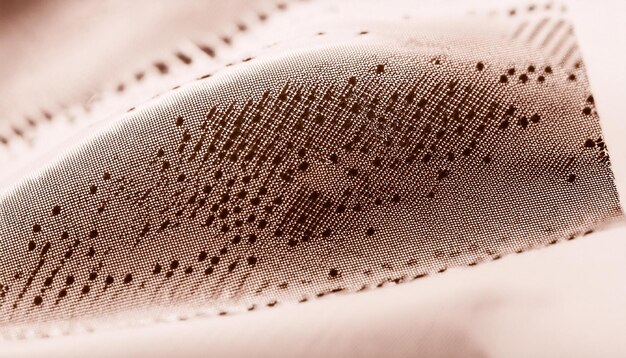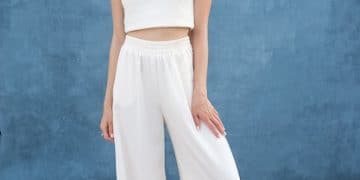Athleisure 2.0: Workout Wear Evolution by 2025

Anúncios
The athleisure market is rapidly evolving beyond casual wear into a sophisticated blend of performance, style, and sustainability, driven by technological advancements and shifting consumer demands, indicating a significant transformation by 2025.
The lines between gym attire, everyday fashion, and even office wear have blurred significantly, shaping what we now call athleisure. But as we approach 2025, the concept of Athleisure 2.0: How Workout Wear is Evolving in 2025 reveals a much deeper transformation, moving beyond mere comfort and style to embrace groundbreaking technology, unprecedented sustainability, and hyper-personalized designs. This evolution isn’t just about what we wear to the gym; it’s about how our clothing integrates seamlessly into every facet of our dynamic lives.
Beyond Comfort: How Performance Fabrics are Redefining Athleisure
The foundation of athleisure’s evolution lies squarely in the advancements of performance fabrics. Gone are the days when workout wear simply meant sweat-wicking properties; 2025 ushers in an era where textiles are intelligent, adaptive, and hyper-functional. This shift is revolutionizing how we interact with our clothing, enhancing not just athletic performance but also daily comfort and environmental responsibility.
Imagine fabrics that can regulate your body temperature based on external conditions, or materials that actively cool you down during intense workouts and provide warmth in cooler environments. These aren’t just concepts; they are becoming commercial realities. The integration of phase-change materials (PCMs) and advanced thermal regulation technologies is creating garments that act as a second skin, dynamically responding to the wearer’s physiological needs. This precise control over personal microclimates allows for unparalleled comfort and optimized performance, whether you’re breaking a sweat or navigating a busy city.
Innovations in Fabric Technology
The pursuit of superior performance has led to incredible leaps in textile engineering. Manufacturers are combining synthetic fibers with natural elements to create hybrid materials that offer the best of both worlds. For instance, merino wool blends provide natural odor resistance and temperature regulation, while recycled synthetics offer durability and moisture-wicking capabilities.
- Smart Textiles: Fabrics embedded with sensors that monitor heart rate, calorie burn, and posture, providing real-time data to connected devices.
- Adaptive Materials: Textiles that can change their physical properties, such as insulation or breathability, in response to external stimuli like temperature or humidity.
- Self-Cleaning Fabrics: Emerging technologies that allow garments to resist stains and odors, reducing the need for frequent washing and extending garment life.
The sustainability aspect of these new materials is equally important. Many innovations are focusing on circularity, from creation to disposal. This includes everything from using natural dyes to developing fabrics that are fully biodegradable or infinitely recyclable. Performance fabrics in Athleisure 2.0 are not just about personal gain; they’re about a broader commitment to ecological impact.
The future of athleisure fabrics is one where science meets style, where every thread is designed with purpose. These advancements are setting new benchmarks for what we expect from our clothing, turning garments into sophisticated tools that support a dynamic and conscious lifestyle.

Sustainability at the Core: Eco-Conscious Athleisure Trends
As consumer awareness of environmental issues grows, sustainability is no longer a niche concern but a central pillar of the athleisure industry. Athleisure 2.0 is characterized by a profound shift towards eco-conscious practices, ranging from material sourcing to manufacturing processes and end-of-life solutions. Brands are recognizing that true innovation must align with planetary well-being, moving beyond mere greenwashing to implement genuinely sustainable models.
The journey towards sustainable athleisure begins with raw materials. There’s a significant move away from conventional virgin polyester and nylon towards regenerated fibers like ECONYL, which is made from ocean waste and discarded fishing nets. Similarly, recycled cotton, hemp, and organic cotton are gaining traction, reducing the demand for new resources and minimizing waste. The focus is on creating closed-loop systems, where materials can be endlessly recycled without losing their quality or performance attributes.
Ethical Production and Circularity
Beyond materials, the spotlight is on ethical production practices. This includes fair labor conditions, reduced water consumption, and lower energy footprints in manufacturing. Transparency in the supply chain is becoming paramount, with brands increasingly providing detailed information about the origins of their products and the conditions under which they are made. This level of traceability helps consumers make more informed choices and holds brands accountable for their environmental and social impact.
- Water-Saving Technologies: Innovations like dye-free fabrics or those using advanced digital printing methods significantly reduce water usage in the finishing process.
- Carbon Neutral Initiatives: Brands investing in renewable energy for their factories or offsetting their carbon emissions through various environmental projects.
- Repair and Recycle Programs: Initiatives encouraging consumers to return old garments for recycling or offering repair services to prolong the life of their products.
The concept of circularity is reshaping the entire lifecycle of athleisure wear. Rather than a linear “take-make-dispose” model, the industry is moving towards a circular economy where products are designed for durability, repair, and eventual recycling. This involves designing garments with single-fiber compositions to facilitate easier recycling or creating products that can be easily disassembled into their component parts.
Ultimately, sustainable athleisure in 2025 is about more than just using recycled bottles; it’s about a holistic approach to design, production, and consumption that prioritizes the health of the planet and its people. This shift reflects a growing understanding that style and performance do not have to come at the expense of environmental integrity.
Tech Integration: Wearables, Smart Apparel, and Digital Fitness
The convergence of fashion and technology is at the forefront of Athleisure 2.0, transforming garments from passive coverings into interactive platforms. By 2025, smart apparel and integrated wearables will not only enhance athletic performance but also provide a seamless link to our digital lives, offering unprecedented insights into health, fitness, and overall well-being. This era is defined by clothing that does more than just fit; it connects, tracks, and empowers.
Imagine your leggings providing real-time feedback on your running form, or your sports bra monitoring your heart rate variability throughout the day. These capabilities are becoming increasingly sophisticated, thanks to advancements in miniaturized sensors, flexible circuits, and washable electronics. The data collected by these smart garments can then be synced with smartphones, smartwatches, or dedicated fitness apps, creating a comprehensive digital ecosystem that personalizes your health journey.
Advanced Sensor Technology and Feedback Systems
The evolution of sensors is key to this technological leap. From bio-impedance sensors that track muscle fatigue to motion sensors that analyze gait and posture, the range of data points collectable is expanding rapidly. This data isn’t just displayed raw; it’s analyzed by AI algorithms to provide actionable insights, personalized training plans, and even injury prevention alerts.
- Integrated Biometrics: Garments with embedded sensors that precisely measure heart rate, respiration, body temperature, and even hydration levels without external devices.
- Haptic Feedback: Apparel that can provide gentle vibrations to guide users during workouts, correct posture, or signal performance milestones.
- GPS and Activity Tracking: Built-in GPS and accelerometers that offer precise tracking of distance, speed, and calories burned without the need for additional gadgets.
Beyond tracking, smart apparel is enabling new forms of interactive fitness. Virtual reality and augmented reality experiences are being integrated with workout wear, allowing users to train in simulated environments or receive dynamic visual cues. This digital overlay transforms mundane workouts into engaging, immersive experiences, blurring the lines between physical activity and gaming.
The development of long-lasting, flexible power sources and seamless connectivity (like 5G and Bluetooth LE) are critical enablers for these advancements. The goal is to make the technology imperceptible, allowing the wearer to focus on their activity while the garment intelligently supports their goals. This integration is not just about convenience; it’s about creating a holistic approach to health and fitness that empowers individuals with continuous, actionable data.
By 2025, athleisure will be less about the clothing itself and more about the advanced digital experiences it facilitates, making personalized wellness more accessible and integrated than ever before.
Personalization and Customization: Tailoring Athleisure to the Individual
In a world saturated with mass-produced goods, the move towards personalization and customization is a defining characteristic of Athleisure 2.0. By 2025, consumers will increasingly demand workout wear that is not only tailored to their unique physiological needs but also reflects their individual style and values. This shift is driven by advancements in digital manufacturing, 3D printing, and sophisticated data analysis, allowing for unprecedented levels of bespoke design.
No longer will “small, medium, large” suffice. The future of athleisure sizing involves body mapping technologies, where garments are designed to fit the precise contours of an individual’s body. This minimizes chafing, maximizes support, and optimizes performance by ensuring the fabric moves in perfect synchronicity with the wearer. Imagine submitting a body scan and receiving a pair of leggings or a sports bra that feels like it was made specifically for you – because it was.
On-Demand Manufacturing and AI-Driven Design
The rise of on-demand manufacturing and 3D printing is making this level of customization economically viable. Instead of large factories producing identical items, micro-factories or even at-home 3D printers can create customized pieces on a smaller scale, reducing waste and lead times. This allows for greater flexibility in design and a rapid response to individual consumer preferences.
- 3D-Printed Components: Customizable elements like sole reinforcements in athletic shoes or targeted compression zones in garments, printed to precise specifications.
- AI-Powered Design: Algorithms that can generate unique patterns, color palettes, or even fabric blends based on a user’s style preferences, activity levels, and even biometric data.
- Modular Designs: Garments with interchangeable parts, allowing users to customize pockets, straps, or even fabric sections to adapt to different needs or styles.
Personalization extends beyond fit to include aesthetic choices. Consumers will have greater control over colors, patterns, and graphic elements, allowing them to express their personality through their athleisure wear. This fosters a deeper connection between the product and the user, transforming clothing into a form of self-expression. Furthermore, the ability to select specific performance features—like enhanced breathability for high-intensity training or extra insulation for outdoor sports—will become standard.
The data collected from smart apparel will also play a crucial role in personalization. Brands can leverage anonymized user data to identify trends, predict consumer needs, and even suggest bespoke product configurations. This data-driven approach allows for a highly responsive and individualized shopping experience, where every garment feels unique.
By 2025, athleisure will be a testament to individuality, with each piece reflecting the unique body, style, and performance requirements of its owner. This move towards tailored solutions underscores a broader shift in consumer values, prioritizing individuality over mass appeal.
Beyond the Gym: Athleisure’s Integration into Everyday Lifestyle
The evolution of athleisure into 2.0 firmly cements its place as a cornerstone of everyday attire, far transcending the boundaries of workout spaces. By 2025, athleisure will not merely be an accepted casual clothing option but a sophisticated and integral component of professional, social, and travel wardrobes. This integration is fueled by designs that seamlessly blend performance wear with fashion-forward aesthetics, making them suitable for a multitude of settings.
The design philosophy of Athleisure 2.0 emphasizes versatility and multi-functionality. Pieces are crafted to look just as polished in a business casual meeting as they do during a yoga session or a walk in the park. This means fabrics that drape elegantly rather than clinging, silhouettes that are both comfortable and refined, and color palettes that are sophisticated and adaptable. Tailoring and subtle detailing are elevating these garments, making them indistinguishable from traditional ready-to-wear clothing in many contexts.
Hybrid Designs and Multifunctional Garments
The concept of “hybrid” garments is key to this integration. These are pieces that combine elements from different fashion categories to create something entirely new and functional. For example, blazers made from stretch performance fabrics, trousers with athletic waistbands that maintain a formal appearance, or dresses that offer moisture-wicking properties while looking chic for an evening out.
- Travel-Friendly Attire: Wrinkle-resistant, quick-drying fabrics ideal for frequent travelers who need versatile outfits that perform well across different climates and activities.
- Smart Casual Hybrids: Designs that blur the line between activewear and traditional smart casual garments, perfect for dynamic work environments or social gatherings.
- Transitional Outerwear: Jackets and coats that offer weather protection and breathability, while featuring urban-inspired designs suitable for city commutes and weekend adventures.
The driving force behind this trend is the modern consumer’s demand for efficiency and practicality. People want clothing that can keep up with their fast-paced lifestyles, minimizing the need for multiple outfit changes throughout the day. This aligns with a broader cultural shift towards valuing experiences and flexibility, where clothing must adapt to diverse schedules and environments without compromising on style or comfort.
Furthermore, the perceived health and wellness benefits associated with athleisure are contributing to its widespread adoption. Wearing comfortable, breathable clothing can implicitly encourage more movement and activity throughout the day, fitting into a holistic approach to well-being. This functional elegance is what sets Athleisure 2.0 apart, marking its widespread acceptance across all aspects of daily life.
By 2025, athleisure will no longer be considered a niche trend but a fundamental aspect of contemporary dressing, proving that utility and high style can coexist effortlessly.
Market Dynamics and Industry Shifts in Athleisure
The evolution of athleisure into its 2.0 phase is profoundly reshaping market dynamics and spurring significant shifts within the fashion and apparel industry. By 2025, the competitive landscape will be marked by intensified innovation, strategic collaborations, and a strong emphasis on direct-to-consumer (DTC) models, all while navigating the complexities of global supply chains and consumer expectations. This isn’t just about new products; it’s about new business paradigms.
Traditional sportswear giants are facing increasing competition from nimble direct-to-consumer startups and luxury fashion houses entering the athleisure space. This diverse competitive field is fostering an environment of rapid innovation, particularly in specialized niches like sustainable activewear, adaptive clothing for varying body types, and tech-integrated garments. Brands are realizing that a one-size-fits-all approach is no longer sustainable, necessitating a focus on specific consumer segments and unique value propositions.
Strategic Diversification and Digital Transformation
Many brands are diversifying their product lines, moving into related categories such as wellness products, athleisure accessories, and even digital fitness subscriptions, creating comprehensive lifestyle ecosystems around their core apparel offerings. This ecosystem approach aims to deepen customer loyalty and increase lifetime value beyond just clothing sales.
- Collaborative Collections: High-profile partnerships between athleisure brands and designers, artists, or even technology companies to create limited-edition collections that drive cultural relevance and buzz.
- Hyper-Focused Niches: The emergence of brands specializing in specific activities (e.g., trail running, specific yoga styles) or demographic segments (e.g., plus-size athleisure, adaptive clothing for disabilities).
- Retail Evolution: The shift from traditional brick-and-mortar stores to experience-driven retail spaces that combine shopping with fitness classes, community events, and wellness services.
The digital transformation of the industry is accelerating. E-commerce remains paramount, but brands are also leveraging advanced data analytics to understand consumer behavior, personalize marketing efforts, and optimize inventory. AI-driven demand forecasting and supply chain optimization are becoming critical for managing production efficiently and reducing waste, especially in an era of unpredictable global events.
Furthermore, the industry is grappling with critical issues like ethical sourcing and labor practices, with increasing pressure from consumers and regulatory bodies. Brands that can demonstrate genuine commitment to social responsibility and environmental stewardship are gaining a significant competitive advantage, while those that fail to adapt risk losing market share.
Ultimately, the market dynamics of Athleisure 2.0 are characterized by agility, purpose, and a relentless pursuit of innovation. Success in 2025 will hinge on a brand’s ability to not only produce cutting-edge garments but also to build authentic connections with consumers through shared values and seamless lifestyle integration.
The Future Landscape: Predictions for Athleisure’s Ongoing Ascent
As we gaze further into the future beyond 2025, the ascent of athleisure shows no signs of slowing; rather, it is poised for even deeper integration and revolutionary advancements. The trends observed in Athleisure 2.0 serve as a launchpad for an era where clothing becomes an even more symbiotic extension of our bodies and digital selves. The landscape will be defined by hyper-intelligent materials, immersive wellness ecosystems, and an unwavering commitment to a circular economy, pushing the boundaries of what apparel can achieve.
One of the most exciting predictions involves the evolution of smart textiles into truly reactive and even predictive garments. Imagine clothes that can not only monitor your health but also anticipate needs, such as automatically adjusting compression to aid muscle recovery post-workout, or providing biofeedback that actively coaches better posture throughout the day. This level of personalized, proactive support will transform garments into essential health and performance companions, making physical and mental well-being seamlessly integrated into daily wear.
Next-Generation Innovations and Societal Impact
The advent of biomimicry in fabric design will bring materials inspired by nature’s incredible efficiencies, leading to self-repairing fabrics that mend minor tears or coatings that mimic plant structures for enhanced water repellency and breathability. Further down the line, we might see garments with adaptive camouflage, changing appearance based on mood or location preference.
- Bio-Integrated Apparel: Clothing that can monitor and even administer micro-doses of wellness compounds or scents based on biometric data or stress levels.
- Holographic Personalization: The ability to project dynamic patterns or virtual displays onto garments, allowing for infinite style customization without purchasing new items.
- Decentralized Production: Advances in accessible 3D printing and localized manufacturing will allow consumers to download and “print” complex garment patterns at home or through local hubs, drastically reducing shipping and waste.
The societal impact of this pervasive athleisure will be profound. It will further dissolve traditional dress codes, normalizing performance-driven comfort in almost every setting. This shift reflects a broader cultural embrace of health, flexibility, and authenticity, where what we wear consciously supports a dynamic lifestyle rather than dictating rigid formality. The global wellness movement will continue to merge with fashion, making functional, smart, and sustainable athleisure the de facto standard.
Furthermore, the circular economy principles that are gaining traction in 2.0 will become entirely ingrained. Repair, reuse, and recycling will be innate to the design and consumption of every garment, with brands competing on their ability to offer truly regenerative product lifecycles. Athleisure’s future is not just about what it enables us to do, but how it fosters a more responsible and interconnected relationship with our clothing and the planet.
The journey of athleisure is a testament to constant innovation, adapting to and shaping human needs and aspirations. Its ongoing ascent promises a future where clothing is truly liberated, serving as a powerful tool for self-expression, performance, and conscious living.
| Key Trend | Brief Description |
|---|---|
| 🔬 Smart Fabrics | Materials now actively respond to body and environment, elevating performance beyond basic wicking. |
| ♻️ Core Sustainability | Focus on recycled materials, ethical production, and circular economy for environmental responsibility. |
| 💻 Tech Integration | Embedded sensors and wearables offer real-time health data and personalized fitness experiences. |
| 🎨 Customization | Tailored fit, personalized aesthetics, and on-demand manufacturing for unique individual needs. |
Frequently Asked Questions About Athleisure 2.0
Athleisure 2.0 moves beyond basic comfort and style, focusing heavily on advanced performance fabrics, deep technological integration (wearables), strong sustainability commitments, and unprecedented levels of personalization. It represents a more mature and sophisticated blending of activewear with everyday fashion, driven by consumer demand for functionality and conscious consumption.
Sustainability is a core driver, pushing brands toward using recycled/regenerated materials like ECONYL, organic cotton, and hemp. It also emphasizes ethical production practices, reduced water consumption, and circular economy models. Consumers are increasingly demanding transparency and accountability, making environmental responsibility a competitive advantage rather than just a trend.
Smart textiles transform garments into interactive tools. They incorporate embedded sensors to monitor biometrics (heart rate, breathing), track performance (form, posture), and even regulate temperature. This tech integration provides real-time data and personalized insights, enhancing both athletic training and overall well-being, blurring the lines between clothing and wearable technology.
Personalization will become far more sophisticated, moving beyond basic sizing. Expect body-mapping technology for precise fit, AI-driven design for unique aesthetics, and on-demand manufacturing (e.g., 3D printing) for custom features. Consumers will have greater control over fit, style, and performance attributes, leading to garments tailored to individual needs and preferences.
Athleisure is integrating seamlessly into all aspects of daily life—work, travel, and social events. Designers are creating versatile, multi-functional pieces that blend athletic performance with fashion-forward elegance, allowing for smooth transitions between activities. Its core principles of comfort, style, and functionality make it an increasingly accepted and sophisticated choice for diverse settings, dissolving traditional dress boundaries.
Conclusion: The Seamless Integration of Life and Style
The journey of athleisure into its 2.0 phase is a compelling narrative of innovation, purpose, and seamless integration. By 2025, workout wear will be far more than just attire for physical activity; it will be a sophisticated, intelligent, and deeply personal extension of our dynamic lives. From advanced performance fabrics that adapt to our physiology, to garments produced with meticulous attention to sustainability and ethical practices, every stitch tells a story of progress. The pervasive influence of technology, enabling hyper-personalization and data-driven wellness, ensures that athleisure continues to evolve at a relentless pace. As consumers increasingly prioritize comfort, functionality, and conscious consumption, athleisure’s fusion into everyday life isn’t just a trend—it’s a definitive shift in how we perceive and interact with our clothing, promising a future where style and well-being are intrinsically linked.






